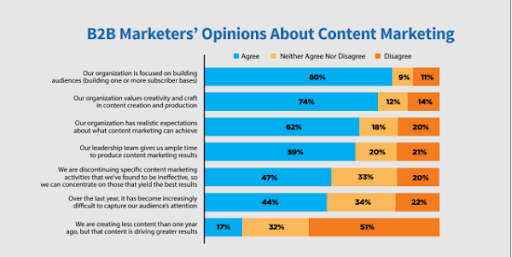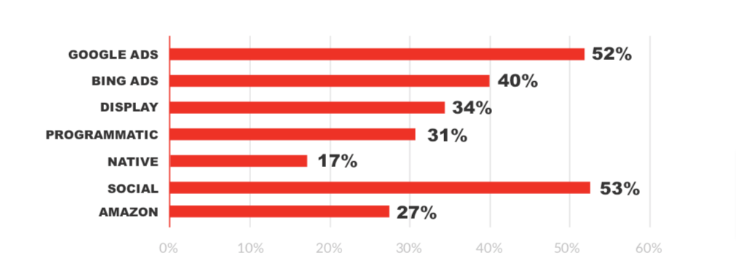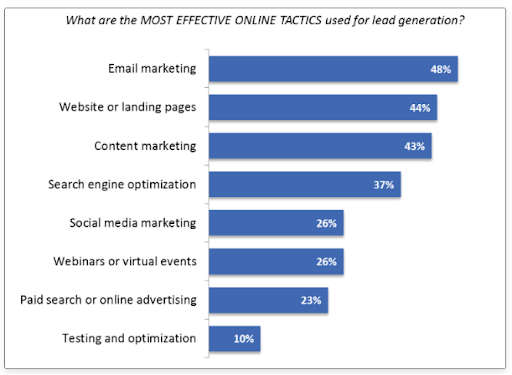B2B Lead Generation: Detailed Guide + 6 Successful Strategies
November 22, 2023
Prashant Shukla
What has been updated from the old blog: Introduction updated. A new section was added to the B2B lead generation process and screenshots were added.
Summary: B2B lead generation is essential for success in the digital age. It involves identifying ideal buyers, nurturing relationships, and using tailored strategies. In this guide, we mention some successful strategies to generate leads that you can’t afford to miss.
In the dynamic world of B2B sales, leads are the backbone of success. But in an era where digital noise competes for your potential customer’s attention, how do you stand out, capture their interest, and turn them into valuable prospects?
Welcome to the treasure trove of B2B lead generation strategies! It’s not just about filling your pipeline; it’s about filling it with the right leads—those eager to engage, convert, and fuel your business growth.
Join us as we embark on an adventure through the time-tested methods that will propel your B2B lead generation efforts to new heights.
Read on to learn more about it!
What is B2B Lead Generation?
To explain in simpler terms, B2B lead generation is a process of identifying and targeting the ideal buyers (key decision makers of a business) who have shown interest in your product and services.This process involves identifying the right customer profiles, collecting their contact details, and building relationships through personalized interactions and content.
There are various strategies, from online marketing to direct outreach, customized for specific industries and audiences. B2B lead generation is essential for maintaining a strong sales pipeline and fostering mutually beneficial business relationships. Therefore, in the next fold, we will discuss how to generate leads through different digital marketing strategies.
Why Using Digital Channels for B2B Lead Generation is Important
Establishing a pipeline for steady leads is a critical consideration, and this is where digital marketing for B2B businesses comes into play:
- B2B digital marketing lays the foundation for sustainable demand and lead generation through SEO, Content Marketing, Paid Media, LinkedIn Marketing, and more.
- Digital marketing can significantly improve your business’s share of voice in the target market, increasing a brand’s recognition.
- Digital marketing can help you target leads across the funnel by creating bespoke campaigns at each stage.
- The advantages of B2B digital marketing are not limited to lead generation. It also aids in positioning you as a thought leader.
B2B Lead Generation Process
B2B lead generation uses two main marketing channels: inbound and outbound.
Inbound marketing attracts leads who find you through sources like social media, online ads, or search engines. These leads often decide to buy more quickly and are more likely to do so.
Outbound marketing, on the other hand, generates leads through direct outreach, like cold calls, email campaigns, and social media. These leads often need more time and attention and take longer to make a purchase.
To generate B2B leads, follow three steps:
Step 1: Define Your Ideal Buyer
Start by creating a buyer persona, a detailed picture of your perfect customer. Think about their industry, job title, information sources, challenges, and what they need. This helps you understand their company, authority, goals, and criteria for making a purchase. You might need different personas for different types of buyers.
Step 2: Choose Your Strategy
Once you know your ideal customers, pick the best strategies to find and engage with them. You have options like SEO, content marketing, paid ads, outreach, community building, and social media. Use tools like landing page builders to capture leads and software for finding emails and email marketing. Focus your efforts on the personas you’ve created and be ready to adjust your strategies.
Step 3: Qualify and Prospect
When you interact with leads, figure out if they’re likely to buy. It depends on their buying stage: awareness, consideration, or decision. Leads in the awareness stage are just starting to recognize their problem, while those in the decision stage are close to making a choice. Match your approach to their stage. Use targeted content like blog posts for awareness and product demos or trials for those closer to a decision. If you have lots of leads, focus on the ones most likely to convert.
6 Key B2B Lead Generation Strategies To Focus on
B2B Leads via SEO
Unlike the B2C (Business-to-Consumer) sphere, where search volumes for keywords can be high due to a larger audience, in B2B, the audience is more niche, so the search volumes for relevant keywords tend to be lower. This means that your SEO strategy should be precise and tailored to your specific audience.
When optimizing for B2B leads, it’s crucial to create content that is not only relevant but also highly tactical and technical, if required. This is because B2B decision-makers often require in-depth information to make informed choices. Your content should provide value and insights that are particularly beneficial to businesses and professionals in your industry.
Best practices for generating B2B leads via SEO include:
1. Find the Right Keywords: Discover words and phrases that matter to your B2B audience. These should mirror what they’re looking for and what they care about.
2. Quality Content: Create top-notch, detailed content that tackles the problems and questions your B2B audience typically has. Show your expertise and provide solutions.
3. Technical SEO: Make sure your website works smoothly, loads fast, and is easy to use on mobile devices. Also, set up your site structure, metadata, and images the right way.
4. Build Good Backlinks: Get links from reputable sources in your industry. These trustworthy links can help your site appear higher in search results.
5. Lead Generation Forms: Place forms within your content to collect contact info. Offer valuable resources or information in exchange for this info.
6. Promote Your Content: Spread the word about your content on social media, through email, and on platforms related to your industry. Connect with influential people and partners to help share your content.
7. Track and Improve: Keep an eye on your SEO efforts using tools like Google Analytics. See how well your content and keywords are doing, and adjust when necessary.
8. Boost Conversions: Make sure your website is set up to turn visitors into leads. Your landing pages and forms should be easy to use and persuasive.
B2B Leads via Content Marketing
The backbone of B2B lead generation is quality content: which provides real value to the users. Good quality and valuable content will position your business as an expert in its domain. It also makes for a natural environment for interaction with prospects and intelligently directs them along the funnel to make purchases.
A B2B content marketing strategy can include:
Create a Lead Magnet With Onsite Content
The first step is to fix or add content to your website. The idea is to increase awareness of your brand and generate traffic and leads, and quality content does just that! Common forms of onsite activities may include creating informative blog posts, infographics, case studies, landing pages, resource centers, etc.

Source: CMI
Irrespective of the industry, the B2B audience always purchases after deliberation. Thus, you need to highlight your expertise, USPs, and value addition in different types of content. More importantly, it should complement the user journey and the sales funnel stage they are in. For instance, blog posts should be about informing the audience about a particular subject matter. Landing pages should have value propositions and CTAs that direct the visitors to make a decision.
Use Guest Blogging
It is one of the most effective ways to establish yourself as a thought leader and make your business a bankable name: only if it is done right.
- First, list out all the non-competing, authoritative websites and blogs catering to your target audience and are ideal for your business to generate good traffic and accept guest blogs.
- Pitch exciting and relevant topics to the editor or the owner of the blog. Be sure to include a great headline, as it will help direct relevant traffic to your website.
- If you receive a favorable response, write an interesting blog that provides valuable information to the reader, and publish it.
- These posts should be organic and directed towards genuinely helping the reader; you should steer clear of self-praises.
Personalize The Content
Everyone likes to read content that caters to their needs. The content should meet the readers’ intent and resolve their pain points. If the reader wants to learn about B2B marketplaces, the content should resolve their queries. Depending on the funnel stage they are in, you should have different kinds of content, like blog posts, whitepapers, product pages, etc., to personalize their experience.
Leverage Quora Marketing
Quora Marketing is a great way for you to establish yourself as a subject matter expert in your domain. However, it should be done mindfully. Use the platform to open lines of communication with people by helping them with their queries or problems related to a certain niche. The best way to establish engagement is by adding value, and Quora is filled with people looking for answers.
Make a LinkedIn Marketing Strategy
LinkedIn can be an excellent platform for brand awareness, engaging with your target audience, and generating leads. More importantly, it is a professional platform, i.e., you can target your B2B audience. Building a LinkedIn marketing strategy requires proper planning, where you use a combination of organic and paid methods to achieve the end objectives.
Also Read: How does Quora Marketing generate leads and engagement?
B2B Leads via PPC
An ideal Pay-per-click (PPC) advertising for B2B businesses includes the following platforms:

Google Ads
Google Ads is the most effective model for paid advertising. Search ads offer an average conversion rate of 3.75%. However, these average numbers primarily depend on the industry. For the B2B industry, this number can be even lower; however, the RoI is significantly better.
To effectively deploy Google Ads for your paid marketing campaigns, optimizing the following aspects is key to increasing the reach, interactions, and leads:
Google Ads (Options)
You need the right combination of ads to find the best-performing ones. For instance, if search ads yield better results than display ads, it is crucial to redefine the campaigns and direct your efforts there.
Landing Page and Ad copies
It is important to optimize the landing page and the ads to highlight the value proposition and improve the placement of CTAs. You need to focus on the design, expertise, and creative elements to ensure this.
Targeted Keywords
Since it is pay-per-click advertising, you need your keywords to be hyper-focused in order to drive quality traffic. If you are running a campaign for a SaaS platform for CRM, the targeted keywords should be in line with the campaign and what the target audience is searching for.
Facebook Ads
Facebook is viewed as one of the most powerful platforms to run paid advertisements due to its data that enables advertisers to run extremely focused ads. Facebook Ads is a great lead generation tool, as it can isolate and target a very specific demographic, one that is most likely to convert. With ad retargeting and well-designed Facebook Ad campaigns, your business can see a great influx of new leads in no time.
LinkedIn Ads
LinkedIn Ads is a part of LinkedIn marketing, and it can help you target the B2B audience by title, industry, and more. There are three types of LinkedIn ads you can target: Sponsored Content, Text Ads, and Message Ads. All these ad types have their advantages and disadvantages and are driven by the industry you are in. This means you need to actively optimize your campaigns by actively checking the analytics to find the best-performing ones that are generating the most leads.
B2B Leads via Affiliate Marketing
Affiliate marketing is when you incentivize another website or entity to promote your product or service in lieu of the commission they’ll receive after the completion of conversion or sale. This channel is viable only if you do it right. From selecting the right B2B affiliate to integrating the incentives, all of this is needed for B2B lead generation through affiliate marketing.
B2B Leads via Email Marketing
With over 4 billion email users in the world and projected growth to 4.6 billion by 2025, this channel holds prominence. However, for B2B email marketing to be successful, you need to get a lot of things right. For instance,
- Your target audience should be interested buyers.
- The emailers should have a good copy and proper CTAs.
- The value proposition should be highlighted correctly.

Source: Neil Patel
Furthermore, here are the strategies you can implement:
- Cold Emails: You need to be creative with the subject lines and the content to get a good response rate from a cold email campaign, and avoid being relegated to spam.
- Newsletters: Utilize a B2B newsletter addressing your subscribers’ needs that are in line with your objectives. You can distribute case studies, white papers, promote podcasts, etc., that genuinely add value to the reader.
- Automate: You can use tools to automate some tasks to bolster operational efficiency. However, you should not lose your focus on the best practices. Automation should be done mindfully while balancing the best practices.
B2B Leads via Referral Program
Nearly 78% of B2B marketers state that referral programs can yield quality leads. To run a B2B referral campaign, you need to identify the right existing customers:
- Paying clients
- Loyal customers
- Willing promoters
If you plan on utilizing an informal way of reaching out to your customers for a referral, the results may not be constructive. However, a strategic approach that targets the right customers and offers the right incentives is an ideal way to bolster leads.
The Final Word
B2B lead generation is quite an overwhelming process that requires you to develop and execute strategies across various channels. More importantly, it is a combination of organic and paid efforts.
In this post, we have outlined all the relevant channels and best practices of B2B marketing for lead generation.
If you have any questions on the topic or would like to learn about our B2B marketing and B2B lead generation services, please connect with our team.